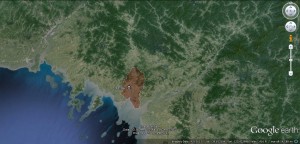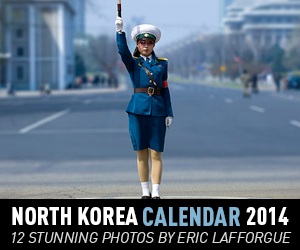
Pictured above (Google Earth): Jongju County
According to Mining.com:
Privately-held SRE Minerals on Wednesday announced the discovery in North Korea of what is believed to be the largest deposit of rare earth elements anywhere in the world.
SRE also signed a joint venture agreement with the Korea Natural Resources Trading Corporation for rights to develop REE deposits at Jongju in the Democratic People’s Republic of Korea for the next 25 years with a further renewal period of 25 years.
The joint venture company known as Pacific Century Rare Earth Mineral Limited, based in the British Virgin Islands, has also been granted permission for a processing plant on site at Jongju, situated approximately 150 km north-northwest of the capital of Pyongyang.
The initial assessment of the Jongju target indicates a total mineralisation potential of 6 billion tonnes with total 216.2 million tonnes rare-earth-oxides including light REEs such as lanthanum, cerium and praseodymium; mainly britholite and associated rare earth minerals. Approximately 2.66% of the 216.2 million tonnes consists of more valuable heavy rare-earth-elements.
According Dr Louis Schurmann, Fellow of the Australasian Institute of Mining and Metallurgy and lead scientist on the project, the Jongju deposit is the world’s largest known REE occurrence.
The 216 million tonne Jongju deposit, theoretically worth trillions of dollars, would more than double the current global known resource of REE oxides which according to the US Geological Survey is pegged at 110 million tonnes.
Minerals like fluorite, apatite, zircon, nepheline, feldspar, and ilmenite are seen as potential by-products to the mining and recovery of REE at Jongju.
Further exploration is planned for March 2014, which will includes 96,000m (Phase 1) and 120,000m (Phase 2) of core drilling, with results reported according to the Australia’s JORC Code, a standard for mineral disclosure similar to Canada’s widely used National Instrument 43-101.
Also from Mining Weekly:
SRE Minerals Limited announces the results of exploration and studies in collaboration with the Korea Natural Resources Trading Corporation of the Democratic People’s Republic of Korea
SRE Minerals Limited (“SRE” or “the company”) announced today their joint venture agreement with the Korea Natural Resources Trading Corporation for rights to develop all rare-earth-element deposits at Jongju, North Pyongan Province.
The joint venture company known as Pacific Century Rare Earth Mineral Limited has the rights under the joint venture agreement which includes the exploration, mining, beneficiation and marketing of all REE deposits in the Jongju area for the next 25 years with a further renewal period of 25 years.
Under the terms of the JV agreement SRE has also been granted permission for a National Rare Earth Mineral Processing Plant on site at Jongju, which is situated approximately 150 km north-northwest of the capital city of Pyongyang, within the North Pyongan Province, Democratic People’s Republic of Korea.
Leading Australian mining and geological consultancy, HDR Salva Resources Pty Ltd, has been SRE’s technical representative for the project and has been commissioned to access the mineralised potential of the Jongju REE target* with special reference to detailed mapping, extensive trenching and limited drilling.
HDR Salva Resources (Pty) Ltd.’s initial assessment of the Jongju REE Exploration Target* indicates a total mineralisation potential of 6.0 Bt (216.2 Mt total rare-earth-oxides including light rare-earth- elements such as lanthanum, cerium and praseodymium (mainly britholite and associated rare earth minerals). Approximately 2.66% of the 216.2 Mt TREO consists of heavy rare-earth-elements. A detailed classification of mineralised potential present in the Jongju REE Target* is presumed to be:
• 664.8 Mt @ >10.00% TREO,
• 1.1 Bt @ 4.72% TREO,
• 579.4 Mt @ 3.97% TREO, and
• 3.63 Bt @ 1.35% TREO.
Dr Louis Schurmann said: “The Jongju Target* would appear to be the World’s largest known REE occurrence.”
Technical information in this announcement has been compiled by Dr Louis W. Schurmann, who is a Fellow of the Australasian Institute of Mining and Metallurgy and a Professional Natural Scientist with over 18 years of experience relevant to the styles and types of rare earth mineral deposits under consideration, and to the activities which has been undertaken to qualify as a Competent Person as defined by the Australasian Code for Reporting of Minerals Resources and Reserves (JORC) 2004. Dr Schurmann consents to the inclusion of information in this publication.
Further exploration is planned to recommence in March 2014, which will include 96,000m (Phase 1) and 120,000m (Phase 2) of core drilling. Results from the exploration program will be reported according to the Joint Ore Reserves Committee of The Australasian Institute of Mining and Metallurgy, Australian Institute of Geoscientists and Mineral Council of Australia (JORC Code (2004 / 2012)).
Investigations by the DPRK’s Academy of Science geologists have also identified several HREE targets*. There are also seven newly discovered carbonatite complexes which have been identified as green-field exploration targets. Exploration programs have been planned to assess their potential in 2014, together with the evaluation of known bastnasite and monazite deposits.
According to the mentioned HDR Salva Resources’ assessment, the Jongju REE Target* also contains economical quantities of rare and critical metals associated with fluorite, apatite, zircon, magnetite, ilmenite, nepheline and feldspar. These commodities will also be addressed during future exploration and further studies.
“This joint venture agreement reinforces the strong and constructive relationship SRE has developed with the DPRK over that time,” he said.
“The REE resource potential of the DPRK, while estimated to be massive has only been lightly explored to date. Given the major economic significance of the effective utilisation of these important minerals to the DPRK, we look forward to working in close co-operation with our partner to progress the development of this excellent opportunity.”
In terms of back ground, the majority of rare earth elements were sourced from placer deposits in India and Brazil in 1948. During the 1950’s, supply came mainly from South Africa, mined from large veins of rare earth-bearing monazite. Then from the 1960’s to 1980’s, rare earths were supplied primarily from the U.S., predominantly from Mountain Pass in California. Competition from China and environmental concerns eventually saw the U.S. operations shut down, and for the last 15 years China has dominated global supply. China today supplies an estimated 90-95% of the global market.
China has recently set quotas to restrict its rare earth exports, and global suppliers have made considerable headway in reducing dependence on Chinese supply. Based on this, several major rare earth companies have been taking advantage of this situation while many junior exploration companies have embarked on exploration programs to add value to small and relatively low-grade REE occurrences.
References to Exploration Target(s)* or Target(s)* in this document are in accordance with the guidelines of the JORC Code (2004). As such it is important to note that in relation to reported Exploration Targets or Target any reference to quality and quantity are conceptual in nature. Exploration carried out to date is insufficient to be able to estimate and report rare-earth mineral resources in accordance with the JORC Code (2004). It is uncertain if further exploration will result in the determination of a rare earth mineral Resource.
Further information will be available at www.pcreml.com and www.sreminerals.com
Here is coverage in Voice of America, Time, The Diplomat.
Read the full story here:
Largest known rare earth deposit discovered in North Korea
Mining.com
Frik Els
2013-12-5


